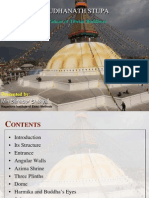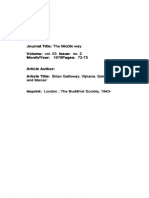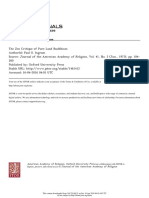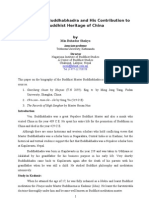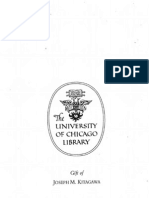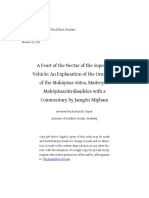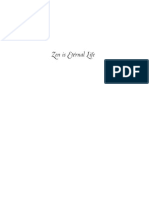虛雲大師 Hsu Yun's Oxherding Poems: Illustrations by Fa Lian Shakya - Greece
虛雲大師 Hsu Yun's Oxherding Poems: Illustrations by Fa Lian Shakya - Greece
Uploaded by
sanshinmonCopyright:
Available Formats
虛雲大師 Hsu Yun's Oxherding Poems: Illustrations by Fa Lian Shakya - Greece
虛雲大師 Hsu Yun's Oxherding Poems: Illustrations by Fa Lian Shakya - Greece
Uploaded by
sanshinmonOriginal Title
Copyright
Available Formats
Share this document
Did you find this document useful?
Is this content inappropriate?
Copyright:
Available Formats
虛雲大師 Hsu Yun's Oxherding Poems: Illustrations by Fa Lian Shakya - Greece
虛雲大師 Hsu Yun's Oxherding Poems: Illustrations by Fa Lian Shakya - Greece
Uploaded by
sanshinmonCopyright:
Available Formats
Hsu Yun's Oxherding Poems
Illustrations by Fa Lian Shakya - Greece
The following is a composite of several translations of Master Xu Yun's "Eleven Stanzas on the Song in Praise of Tending an Ox as Requested by the Students of Gushan Buddhist Institute." Unfortunately, we do not have the actual pictures Xu Yun was looking at when he wrote his comments.
1. Pushing Aside the Grass to Look for the Ox
Wanting to break through to Emptiness with my white cudgel I cried out louder than the bellowing Ox, mooing through my senses. I followed mountain and stream searching for the Ox, seeking it everywhere. But I couldn't tell in which direction it had gone... west?... or east?
2. Suddenly Seeing Tracks
On I searched... into the mountains and along the river banks. But in every direction I went, I went in vain. Who would have suspected that it was right where I stood; That I needed only nod my head and my true Self would appear before me.
3. Seeing the Ox
Its wild nature is now calmed in lazy sleep. By the stream, under the trees, crushing the blades of dew laden grass The Ox sleeps without a care. At last I have found it... there with its great head and horns.
4. Piercing the Ox's Nose
I rush forward and pierce the Ox's nose! It wildly jerks and jumps But I feed it when it is hungry and give it water when it thirsts. Then I allow the Oxherding Boy to take care of it.
5. Training the Ox
I have supported you with great care for many years And you plow - not mud and water, but clouds! From dawn until dusk, the natural grass sustains you And you keep your master company by sleeping out of doors.
6. Returning Home Riding the Ox
What place in these cloudy mountains is not my home? There's greenery everywhere - so lush it's hard to tell Crops from wild grasses. I don't intrude on planted fields. I ride the Ox and let him graze along the roadside.
7. Keeping the Person Because of the Ox
I went from the city to the edge of the sea I returned riding backwards in a white ox wagon. Into this painted hall comes a spinning red wheel. The New Bride finally arrives, and from my own house!
10
8. The Bride and the Ox are Forgotten
I remember the old days as I brush out dead ashes from the cold stove. Silently, without a trace, I pace back and forth for no reason. But today the ice is broken by a plum blossom! A tiger roars, a dragon growls, and all the creatures of the universe surround me.
11
9. Returning to the Origin and the Essence
Every thing and every creature under the sun has its own nature. Hasn't this knowledge been passed down through generations? When the Ox suddenly roars like a lion Everything in the universe reveals such infinite variety.
12
10. Coming Home with Folded Hands
How wide are the horizons of the spinning earth! The moonlight leads the tides and the sun's light will not be confined Within the net of heaven. But in the end all things return to the One. The deaf and dumb, the crippled and deformed are all restored to the One's Perfection.
13
11. The Concluding Song
In the beginning there was nothing, nor was anything lacking. The paper was blank. We pick up the paint brush and create the scene... The landscape, the wind whipping water into waves. Everything depends upon the stroke of our brush. Our Ox lets the good earth lead it, Just as our brush allows our hand to move it. Take any direction, roam the world to its farthest edge. All comes back to where it started... to blessed Emptiness.
14
Introduction to Empty Cloud
by Richard Hunn, from Empty Cloud: The Autobiography of the Chinese Zen Master
Long before the time of his death in 1959 at the venerable age of 120 on Mount Yun-ju, Jiangxi Province, Master Xu-yun's name was known and revered in every Chinese Buddhist temple and household, having become something of a living legend in his own time. His life and example has aroused the same mixture of awe and inspiration in the minds of Chinese Buddhists as does a Milarepa for the Tibetan Buddhist tradition, remarkable in view of the fact that Xu-yun lived well into our own era, tangibly displaying those spiritual powers that we must otherwise divine by looking back through the mists of time to the great Chan adepts of the Tang, Song and Ming Dynasties. They were great men whose example still inspires many today, but in many cases, we have scant details as to their lives as individuals, outside their recorded dialogues or talks of instruction. The compelling thing about Xu-yun's story which follows is that it paints a vivid portrait of one of China's greatest Buddhist figures complete with all the chiaroscuro of human and spiritual experience. It is not a modern biography in the Western sense, it is true but it does lay bare the innermost thoughts and feelings of Master Xu-yun, making him seem that much more real to us. No doubt, the main thing for a Buddhist is the instructional talks, and Xu-yun's are rich in insight, but it is only natural that we should wonder about the individual, human factors, asking what life was like for these fascinating figures. After all, holy men are like mountains, while their 'peaks of attainment' may thrust into unbounded space, they must rest on the broad earth like the rest of us. That part of their experience-how they relate to temporal conditions--is an intrinsic part of their development, even if the ultimate goal be to 'pass beyond' the pale of this world. In Xu-yun's account we are given a fascinating glimpse into the inner life of a great Chinese Buddhist Master. By the time of his passing, Xu-yun was justifiably recognised as the most eminent Han Chinese Buddhist in the 'Middle Kingdom'. When he gave his talks of instruction at meditation meetings and transmitted the precepts in his final decades, literally hundreds of disciples converged upon the various temples where he met and received his followers and, on some occasions, this number swelled to thousands. Such a wave of renewed enthusiasm had not been witnessed in the Chinese monasteries since the Ming Dynasty 15
when Master Han-shan (1546-1623) appeared. This eminent Master had also found the Dharma in decline and set about reconstructing the temples and reviving the teachings, as would Master Xu-yun some three hundred years or so later. Only years before these great gatherings around Master Xu-yun, many of the temples which he was subsequently to use had been little more than ruined shells, decrepit shadows of their former grandeur and vitality, but the Master revived these along with the teachings that were their very raison
d'etre.
Not surprisingly, Xu-yun soon acquired the nickname 'Hanshan come again' or 'Han-shan returned', for their careers were in many respects similar. Both had shared the ordination name of 'De-qing' and both had restored the Monastery of Hui-neng at Cao-xi among others in their times. However, unlike his eminent predecessors in the Tang, Song and Ming Dynasties who had frequently enjoyed official patronage and support from Emperor and State, Xu-yun's long life of 120 years spanned a most troublesome time both for China and Chinese Buddhism. It was a period continually punctuated by both civil and international conflict, with almost perpetual doubt and confusion as to China's future and security, one in which general want and straitened circumstances were the order of the day. Xu-yun was born in 1840 around the time of the Opium Wars and by 1843 the Treaty of Nanjing had been signed with the ceding of Hong Kong to Great Britain, the thin end of a wedge of foreign intervention in China's affairs that was to have fateful and longlasting repercussions. Xu-yun lived to see the last five reigns of the Manchu Dynasty and its eventual collapse in 1911, the formation of the new Republican era taking place in the following year. With the passing of the old order, much was to change in China. China's new leaders were not that concerned about the fate of Buddhism and indeed, many of them were inclined to regard it as a medieval superstition standing in the way of all social and economic progress. The waves of modernism sweeping China at this time were not at all sympathetic towards Buddhism nor any other traditional teachings. Needless to say, many of the monasteries found themselves falling on hard times and many others had already been in ruins before the fall of the dynasty. Government support for the Buddhist temples was scanty when not altogether absent. Of course, China's new leaders had other things on their minds, for besides the frequent famines, droughts and epidemics which ravaged China during these years, there was also the growing threat of Japanese
16
invasion. The Communist Chinese were rising in the countryside, soon to find sufficient strength to take on the Nationalist armies. By the late 1930s, Japanese troops occupied large areas of northern China. It goes without saying that this unfortunate social and political climate hardly offered the best of circumstances in which to embark upon largescale renewal of the Chinese Buddhist tradition. However, despite the odds stacked against him by dint of all this chaos, Xu-yun succeeded in retrieving Chinese Buddhism from abysmal decline and actually injected fresh vigour into it. In many ways, the story of Xu-yun is the story of the modern Chinese Buddhist revival, for by the end of his career, he had succeeded in rebuilding or restoring at least a score of the major Buddhist sites, including such famous places as the Yun-xi, Nan-hua, Yun-men and Zhen-ru monasteries, besides countless smaller temples, also founding numerous Buddhist schools and hospitals. His followers were scattered throughout the length and breadth of China, as well as in Malaysia and other outposts where Chinese Buddhism had taken root. During the Master's visit to Thailand, the King became a personal disciple of Xu-yun, so impressed was he by the Master's example. Xuyun's life-work would have been an achievement of note even during more auspicious days when official patronage had been freely given, but that this tenacious and devoted spirit succeeded in his aims amid the general want and turmoil of his times was even more remarkable and nothing short of miraculous. This was possible only because of the Master's deep spiritual life, which alone could provide the energy for renewal amid confusion and decay. His external works were a reflection of the inner life he cultivated and one of a piece. To many Chinese Buddhists, Xu-yun appeared like an incarnation and personal embodiment of all that was great about the Chinese Sangha in the halcyon days of the Tang and Song, and as a modern scholar in the West put it, Xu-yun 'lived hagiography', his life strangely infused with the spirit of greater times. The Master's restoration work was often bidden in strange ways, as if a hidden reservoir of the whole Chinese Buddhist tradition wished to speak anew through his very being. When serving as Abbot of Gu-shan Monastery, Fujian, in 1934, the Master beheld the Sixth Chan Patriarch (d. 713) in his evening meditation. The Patriarch said, 'It is time for you to go back.' thinking that this betokened the end of his earthly career, the Master said a few words about it to his attendant in the morning and then put it out of mind. In the fourth month of that same year,
17
he again beheld the Patriarch in a dream, who this time thrice urged him to 'go back'. Shortly afterwards; the Master received a telegram from the provincial authorities in Guangdong, inviting him to take over and restore the Sixth Patriarch's monastery at Caoxi, then in just the same dilapidated condition as Han-shan had found it back in the Ming Dynasty before his own restoration work. Thus, Xu-yun handed over Gushan Monastery to another Abbot and proceeded to Cao-xi to set about restoring the famous Nan-hua Monastery, formerly known as 'Bao-lin' or 'Precious Wood', and from which the Chan Schools of yore had received their impetus and inspiration. Throughout the Master's long career, whether in good fortune or bad, he remained a simple and humble monk. Those who met him, including the usually more critical Western observers, found him to be thoroughly detached from his considerable achievements, unlike one or two other Chinese Buddhists who had welcomed publicity and selfglorification as instruments behind the Chinese Buddhist renaissance. While many talked, Xu-yun quietly went his way, as unaffected as the 'uncarved block' so dear to a wise Chinese heart. Again, despite the munificence of the temples he helped to restore, his noble simplicity remained entire. When the Master approached a holy site for restoration, he took a staff with him as his only possession; when he had seen his task completed, he left with that same staff as his sole possession. When he arrived at the Yun-ju mountain to restore the Zhen-ru Monastery, then a shambles, he took up residence in a cowshed. Despite the large sums of money which came in from devotees during restoration, the Master remained content with his simple cowshed and still preferred it, even after the Zhen-ru Monastery had risen, phoenix-like, from its ashes. But this was to be expected from a monk who had once lived on nothing but pine needles and water while on retreat in the mountain fastness of Gu-shan. Famous, too, were the Master's long pilgrimages on foot to holy sites at home and abroad, totally at the mercy of the elements and often with little more than his faith to support him. His greatest plgrimage began in his 43rd year when he set out for the isle of Putuo in Zhejiang, sacred to Avalokitesvara Bodhisattva. Carrying incense in hand, he prostrated every third step of the way to pay reverence to the 'three gems'. Thence in a similar fashion, he headed for Mount Wu-tai in Shansi, sacred to Manjusri Bodhisattva, one point of his pilgrimage being to pay back the debt of gratitude he felt towards his parents; the strength of his determination can well be measured by the fact that he nearly perished
18
twice in the bitter cold of Wu-tai's snowy peaks but never gave up. He was saved by a beggar named Wen-ji, regarded by Chinese Buddhists as a 'transformation-body' of Manjusri. From Mount Wu-tai, the Master headed towards Tibet, which he visited, going on to Bhutan, India, Ceylon and Burma before returning to China via Yunnan, calling at holy sites en route. During his travels the Master succeeded in realising 'singleness of mind' throughout day and night, so that by the time of his return to China, conditions were ripe for his final or complete enlightenment, which took place in his 56th year while at the Gao-min Monastery in Yangzhou. He was, as the Chinese say, one who had 'ancient bones', for as regards his later career of restoration which included reviving the teaching of the Five Chan Schools (Wu-jia), the Master was very much a 'self-made man' who had re-established these teachings on the strength of his own insight without teachers. A flash of the old insight was to be found here and there in the temples as Xu-yun had known them in his youth, but the Chan tradition had been in decline by and large. His first teachers had been either Dharma-Masters or Tian-tai Masters, though indeed his Tian-tai teacher had given him his first gong-an [Jap. koan] ('Who is dragging this corpse about?') and it would not be true to say that the Chinese temples had been totally lacking in enlightened individuals. The marked revival of the Chan tradition in the period extending from the mid-1930s through to the 1950s was largely attributable to Xu-yun's endeavours. The Master cared greatly for lay-Buddhists, too, and he was progressive for the way in which he opened up the temple doors to layfolk, teaching them alongside Sangha members. He made much of the pu-shuo or 'free sermon' end addressed all who came to him. Though a monk for 101 years, he never pretended that the Dharma was beyond the reach of layfolk. While his gathas and verses of instruction reveal the insight of one who saw beyond the pale of this world, he never failed to remind his disciples that the great bodhi is ever-present, always-there in our daily acts and seemingly mundane circumstances. Like all the great Masters of Chan before him, he laid stress on the nonabiding mind which is beyond reach of all conditioned relativities, even as they arise within it, a paradox that only the enlightened truly understand. Though the Master became famous as a Chan adept, he also taught Pure Land Buddhism, which he considered to be equally effective as a method of self-cultivation, for like the huatou technique, the single-minded recitation of the Pure Land mantra stills the dualistic 19
surface activity of the mind, enabling practitioners to perceive their inherent wisdom. This will surprise some Western people who tuned in to the 'Zen craze' a few years back, in which it was often said that Chan or Zen Masters eschewed use of the Pure Land practice. Also, contrary to what has been said on occasions, Xu-yun gave regular talks of instruction on the sutras and shastras, which he knew thoroughly after many decades of careful study and which he understood experientially, in a way which went beyond the grasp of mere words, names and terms in their literal sense. By the time Xu-yun had rebuilt the physical and moral fabric of Chinese Buddhism, few of the disciples who gathered round the Master or attended the other temples he rebuilt had to suffer the same indignities and privations that he had experienced himself when calling at monasteries in his youth. He had often been turned away from temples that had fallen into the degenerate system of hereditary ownership, not even allowed a night's lodging. When he had called at some temples, only a handful of monks were to be found because of the general decline. In one instance, famine had reduced the whole population of locals and monks at one site to just a single person who used to put on a 'brave face' if callers happened by. Given that kind of background, it is hardly surprising that Xu-yun recognised the need to recreate that self-sufficiency extolled by the ancient Master Bai-zhang Hui-hai (d. 814) in his famous dictum, 'A day without work, a day without food'. Thus, wherever possible, Xu-yun revived the monastic agricultural system to live up to this tradition of selfsufficiency. Thus far, all the necessary ingredients were present to sustain a revival which had borne fruit through decades of devoted effort. But we now come to a most tragic interlude in the life of Xu-yun which might well be called a 'twilight of the gods' were it the finale, though thankfully it was not. As is well known, the Communist Government took effective control of China in 1949 about the time that Xu-yun had set his aim on restoring the Yun-men Monastery in Guangdong. By 1951-52 the first tremors of what was to follow in the Cultural Revolution were beginning to make themselves felt. The restoration of the Yun-men Monastery was more or less complete, but misfortune struck from without with a purge of so-called 'rightist elements' in Guangdong Province. Being very much a 'traditionalist' in outlook, Master Xu-yun was an obvious target. Fears that Xu-yun might not be safe in the volatile atmosphere of these times had been voiced, the Master's overseas disciples urging him to leave the mainland until things settled down. He refused to leave, however,
20
expressly because he felt that it was his duty to look after the welfare of the monasteries. What happened next was almost inevitable; a horde of Communist cadres descended on the Yun-men Monastery which they surrounded. They locked the Master up in a room for several days, where he was interrogated and ruthlessly beaten, left for dead. Perhaps the less said about this episode, the better. Suffice it to say that the Master had broken ribs and bled profusely, being for a while most seriously ill. Remarkably enough though, while then in his 112th year, Xu-yun recovered from a beating severe enough to have killed someone less than half his age. This was not the first time that he had been beaten, for the police in Singapore had roughed him up back in 1916, ironically enough on the suspicion of being a 'leftist' from the mainland. But the beating he suffered in his 112th year was infinitely worse. Even so, without trying to make too little out of the violence he suffered, the old Master bounced back with all the properties of a proverbial 'Daruma doll' and lived to carry on teaching not only at the Yunmen Monastery but many others besides, also finding time and energy for one more round of restoration work at the Zhen-ru Monastery on Mount Yunju, Jiangxi Province, where he eventually departed from this world on 13 October 1959. He had been in the Sangha for 101 years. With the Master's passing in 1959, the Cultural Revolution was just around the corner. As we know, the monasteries had to suffer bitterly during that period. For many monks, nuns and lay devotees, it must have seemed that everything the Master had striven for was about to sink into oblivion. That draconian measures were already evident in Xu-yun's last years must have caused him some concern; as it was, the episode at Yun-men cost him his most able disciple, Miao-yuan, who was executed. Other disciples had been harmed too. Things did look bleak, and even the news of events at Yun-men had to be smuggled out of mainland China by inserting records in the blank innerfolds of traditionally bound Chinese books. But as many on the mainland today are prepared to admit, the excesses of the Cultural Revolution were wrong; few would disagree. Whether the long-term effects of ideological reform have been as catastrophic for Chinese Buddhism as once predicted is a good question. We should not deceive ourselves into thinking that Buddhism had been immune from persecution under the ancient regime. In the Hui-chang period (842-5) of the Tang Dynasty, a massive purge of Chinese Buddhism took place with the near destruction of some 4,600 monasteries, with 260,000 monks and nuns being forced back into lay life, the confiscation of monastic property and land being
21
widespread. The monasteries managed to recover from that and by way of contrast, the modern picture is not entirely pessimistic. It is some consolation to learn that the temples which Xu-yun restored are not only being patched up after the ravages of the revolution, but that many are being restored to their proper use and once more assuming an air of normality, though the complement of monks and nuns is much smaller these days. At any rate, these are not the 'actor monks' shuffled around China by the authorities twenty years ago, who fooled nobody, but bona fide occupants. Of this I have been given reliable assurance from two sources, my friends Dharma-Master Hin-lik and Stephen Batchelor (Gelong Jhampa Thabkay), both of whom made recent visits to the monasteries in southern China. Thus, rather than ending on a pessimistic note, we should rejoice in the fact that Xu-yun's endeavours did not fall entirely on stony ground. Without the energies he released into Chinese Buddhism, it is quite likely that the Chinese Sangha would have suffered far greater setbacks than it did during the revolution. In this sense, Master Xu-yun lived out the mythical role of the 'poison-eating peacock' in Buddhist lore; from the bitterness of that poison something spiritual sprang forth. In the long run it seems that, as with the suppression of Buddhism in Tibet, the suppression of Chinese Buddhism has had the precise opposite effect to that intended by the suppressors. Not only has the Asian Buddhist had to reappraise the worth of the Dharma in his own context, but its merits have also struck the attention of the whole world. Was it merely coincidence that at the height of the Cultural Revolution in China, copies of Lao-zi and Chan (Zen) texts went into record numbers of reprints in the West? Anyone at all familiar with the Jungian theory of synchronicity would find it hard not to see this phenomenon as a profound act of compensation in the collective psyche. Some things are meant to be and cannot be destroyed. Though all outward signs and symbols may be denied for a while, their inner archetypes always remain and, like seeds, they reassert themselves. It is salutary to note in this respect that no lesser person than the late C. G. Jung was reading Xu-yun's Dharma-discourses while on his death-bed. Over the years, the editor has received a number of letters from home and abroad inquiring about Xu-yun, his life and teachings. Such interest has sprung from a variety of sources and lands ranging from Europe, Australia and the USA, to Scandinavia and even a small South American state. In view of such wide interest, the story of Xu-yun's life will 22
appeal to many, for while his teachings have been available for years, the autobiography has so far appeared only in limited editions. In America, Roshi Philip Kapleau has read from Xu-yun's account to inspire his students at the Rochester Zen Center. This could only be because Xu-yun's story is a testimony to the deep human need for spiritual nourishment. When reading the story of the Master's quest, we see a reflection of our own therein. He symbolises the 'great man' hidden in ourselves and his name 'Empty Cloud' reminds us of that greater, 'undiscovered Self' that we are all fated to explore. So much then for the great man with whom our text deals; a brief word must now be said about the text itself. It is a cause for rejoicing that a new edition of Empty Cloud is to become available under the banner of Element Books. Though Xu-yun's teachings are quite widely known via the Discourses and Dharma Words translated by Upasaka Lu K'uan Yu (Charles Luk) in his Chan and Zen Teaching series (see Bibliography), Lu's translation of the Master's biography never saw regular publication, though limited editions have indeed appeared, once in the USA, through the inspired initiative of Roshi Philip Kapleau and friends at the Rochester Zen Center (1974), and an English edition (1980), thanks to the editor's friends who helped finance that version. In anticipation of further reprints, it seemed advisable to incorporate a number of corrections, revisions and additions to bring the text up to date. Some of these errors had been drawn to my notice by Upasaka Lu back in 1975 and vice versa, but as Lu sadly passed away in 1978 he was unable to make further revisions. To compensate, I have checked the translation several times against the Xu-yun He-shang Nian-pu from which Lu worked, incorporating whatever changes seemed to be required, including extra notes, minor additions, a glossary, etc. although the translation is still basically Luk's original which first appeared in serialised form in World Buddhism back in the 1960s, several passages have either been rewritten or added, and to that extent constitute new translations. Another modification has been to substitute the pinyin form of romanisation; this is rapidly becoming the standard form in the West and it is also the form that visitors will find used in China in guidebooks and publications. I have departed from this in two or three instances, as in the retention of Canton for Guangzhou, the old form still being used in guidebooks; I have kept Amoy for Xiamen, and in order to avoid an apparent ambiguity likely to ensnare 23
the general reader, I have kept the old spellings of Shensi and Shansi (pinyin: Shaanxi and Shanxi). Again, while not quite orthodox, I have hyphenated some pinyin names more than usual so as to recall the older spellings. Readers with pinyin should have no trouble with 'Bao-lin' and those familiar with Wade-Giles will readily spot the transition from 'Pao-lin'. Written as 'Baolin', however, the name is not identifiable in the same way. I have retained the Chinese li as a measurement of distance, for it is much shorter than the English mile (about 1/3 mile) and should pose no more problems than the kilometre in Continental writings. As a final note, it is worth reminding readers that Luk's translation was made from the early edition of Xu-yun's biography; in recent years this has been expanded to include collections of the recorded teachings and lectures given at many monasteries, in fact extra books. To translate all of this material would be interesting, but something of a magnum opus for the would-be translator. However, a couple of supplementary records have been added in this edition. Extra sources of Xu-yun's teaching, both English translations and Chinese originals, are listed in the bibliographical section. May all beings attain release! UPASAKA WEN SHU (RICHARD HUNN) Tholpe Hamlet, Norwich. 13 October 1987. The Anniversary of Xu-yun's Nirvana. Copyright The Executers of the late Charles Luk 1988
24
Introduction to the Ten Oxherding Pictures
by Urs App
The protagonist of this poetic picture story, a boy herdsman, stands for none other than you, dear reader. It is the very "I" that reads these lines through a pair of eyes, the subject of your life, the protagonist of that unique story that is yours. It is what thinks your thoughts, makes your plans, has your desires, and signs your checks: it is what was born of your parents and will die on your deathbed. This "I" is also the starting point of the Zen Buddhist quest. When a Chinese man called Huike, according to a Zen story, met Bodhidharma, the following conversation ensued: Huike: "Please, Master, bring peace to my heart-mind!" Bodhidharma: "Show it to me, and I will pacify it! Huike: "I have searched for it, but I could not find it." Bodhidharma: "If you could search for it, how could it be your very own heart-mind?" In Zen Buddhism, the injunction "show me your self" has a particular ring, as the root-source of man's basic dissatisfaction and the engine of his striving is none other than this "I". The Japanese Zen master Bankei, for example, diagnosed the basic human problem as follows: Your self-partiality is at the root of all your illusions. There aren't any illusions when you don't have this preference for yourself. Rather than being the goal of man's quest, Zen thus sees the "I" as the very problem. Thus the herdsman, who has an "I" just as all of us do, sets out in search of what he truly is. The object of this search, man's true self, is represented by an ox or buffalo. The quest extends from the seeing of faint traces (picture 2) to the thorough overcoming of the problematic "I" with all of its objects (including the ox; picture 8) -- and to the emergence of nature as it truly 25
is (9). In the Indian Upanishads, the highest spiritual goal is the realization that one's own true self, one's atman, is nothing other than the very essence of everything, i.e., brahman. "Tat tvam asi", "That thou art," is its expression. In terms of the present classic of Zen literature, the Ten Oxherding Pictures, that means: your true self, what you really are without realizing it, is nothing other than that ox and that flower, or your neighbor.Thus the true man in picture 10 is not aloof from the world but rather right here, in the bustle of the marketplace.
26
You might also like
- Brahmas Net SutraDocument134 pagesBrahmas Net SutranyomchenNo ratings yet
- Holmes Welch - The Practice of Chinese Buddhism, 1900-1950 (1967) PDFDocument596 pagesHolmes Welch - The Practice of Chinese Buddhism, 1900-1950 (1967) PDFjfreixooliveira100% (1)
- Buddhist Scriptures As Literature - Sacred Rhetoric and The Uses of Theory - Ralph FloresDocument234 pagesBuddhist Scriptures As Literature - Sacred Rhetoric and The Uses of Theory - Ralph Floreskstan1122No ratings yet
- Gregory Schopen - If You Can't Remember, How To Make It Up: Some Monastic Rules For Redacting Canonical TextsDocument12 pagesGregory Schopen - If You Can't Remember, How To Make It Up: Some Monastic Rules For Redacting Canonical TextsƁuddhisterie2No ratings yet
- Chappell-Teachings of The Fourth Ch'an Patriarch Tao HsinDocument41 pagesChappell-Teachings of The Fourth Ch'an Patriarch Tao HsinAndy FrancisNo ratings yet
- Brill's Encyclopedia of Buddhism: LivesDocument8 pagesBrill's Encyclopedia of Buddhism: Lives1011760% (1)
- Bodhnath Stupa and Its EnvironmentDocument71 pagesBodhnath Stupa and Its EnvironmentMin Bahadur shakyaNo ratings yet
- Vijnana, Samjna, and ManasDocument5 pagesVijnana, Samjna, and ManasGuhyaprajñāmitra3100% (1)
- Nourse - Canons in Context PDFDocument248 pagesNourse - Canons in Context PDFYoyoyo SmithNo ratings yet
- Artur Koterel - Rečnik Svetske MitologijeDocument230 pagesArtur Koterel - Rečnik Svetske MitologijePavle Bosnić100% (4)
- Records of the Transmission of the Lamp: Volume 7 (Books 27-28) Biographies and Extended DiscoursesFrom EverandRecords of the Transmission of the Lamp: Volume 7 (Books 27-28) Biographies and Extended DiscoursesNo ratings yet
- Record of the Transmission of the Lamp: Volume One: The Buddhas and indian patriarchsFrom EverandRecord of the Transmission of the Lamp: Volume One: The Buddhas and indian patriarchsRating: 4 out of 5 stars4/5 (2)
- Records of the Transmission of the Lamp: Volume 3: The Nanyue Huairang Lineage (Books 10-13) – The Early MastersFrom EverandRecords of the Transmission of the Lamp: Volume 3: The Nanyue Huairang Lineage (Books 10-13) – The Early MastersNo ratings yet
- Records of the Transmission of the Lamp (Jingde Chuandeng Lu): Volume 8 (Books 29&30) – Chan Poetry and InscriptionsFrom EverandRecords of the Transmission of the Lamp (Jingde Chuandeng Lu): Volume 8 (Books 29&30) – Chan Poetry and InscriptionsNo ratings yet
- Hamar, Imre 2007 Reflecting Mirrors Perspectives On Huayan Buddhism PDFDocument416 pagesHamar, Imre 2007 Reflecting Mirrors Perspectives On Huayan Buddhism PDFWendy RodriguezNo ratings yet
- Alayavijnana Origin and Development PT 1Document243 pagesAlayavijnana Origin and Development PT 1Todd BrownNo ratings yet
- Ingram, The Zen Critique of Pure Lan BuddhismDocument18 pagesIngram, The Zen Critique of Pure Lan BuddhismJaimeGuzmanNo ratings yet
- Koans in The Dogen TraditionDocument20 pagesKoans in The Dogen TraditionmichihisashiiNo ratings yet
- Tony Page - Affirmation of Eternal Self in The Mahāyāna Mahaparinirvana SutraDocument9 pagesTony Page - Affirmation of Eternal Self in The Mahāyāna Mahaparinirvana SutraAni LupascuNo ratings yet
- O'Donnel, P. - Buddhism - A Select BibliographyDocument55 pagesO'Donnel, P. - Buddhism - A Select Bibliographydogdog22209006No ratings yet
- Points of Controversy (Kathavatthu), Aung, Davids, 1915Document480 pagesPoints of Controversy (Kathavatthu), Aung, Davids, 1915vannguyen1007100% (1)
- A Note On BuddhabhadraDocument10 pagesA Note On BuddhabhadraMin Bahadur shakya100% (1)
- Choo Hyun - Wonchuk's Commentary of The Heart SutraDocument85 pagesChoo Hyun - Wonchuk's Commentary of The Heart SutraWu100% (1)
- Hugh Edward Richardson - A Tibetan Inscription From Rgyal Lha-Khan and A Note On Tibetan Chronology From AD 841 To AD 1042Document26 pagesHugh Edward Richardson - A Tibetan Inscription From Rgyal Lha-Khan and A Note On Tibetan Chronology From AD 841 To AD 1042Enes AdıgüzelNo ratings yet
- The Lankavatara Sutra - A Mahayana Text Translated by Daisetz Teitaro Suzuki (1932)Document372 pagesThe Lankavatara Sutra - A Mahayana Text Translated by Daisetz Teitaro Suzuki (1932)morefaya2006No ratings yet
- Jiabs 29-2Document220 pagesJiabs 29-2JIABSonline100% (2)
- PlatformSutra McRaeTranslationDocument172 pagesPlatformSutra McRaeTranslationidunnololNo ratings yet
- Dōgen's Deeper EcologyDocument26 pagesDōgen's Deeper Ecologymyatchitshin4121No ratings yet
- Chapter 10: Masters of The DharmaDocument11 pagesChapter 10: Masters of The DharmaemasokNo ratings yet
- Chih I Lotus Symbolism and The Lotus Sutra PDFDocument12 pagesChih I Lotus Symbolism and The Lotus Sutra PDFmansur hirbiNo ratings yet
- 210 221 - Payne - A Feast of The Nectar of The Supreme VehicleDocument14 pages210 221 - Payne - A Feast of The Nectar of The Supreme VehicleFred FrogNo ratings yet
- Honen The Buddhist Saint-Essential Writings and Official BiographyDocument2 pagesHonen The Buddhist Saint-Essential Writings and Official Biography순수정토No ratings yet
- Tibetan Buddhism in Western Perspective (Herbert v. Guenther)Document6 pagesTibetan Buddhism in Western Perspective (Herbert v. Guenther)hannahjiNo ratings yet
- Zen Is Eternal LifeDocument374 pagesZen Is Eternal Lifecyberbiopunk100% (3)
- Buddhist Forum VIDocument269 pagesBuddhist Forum VIའཇིགས་བྲལ་ བསམ་གཏན་No ratings yet
- A Study of Mahayanasamghara III: The Relation of Practical Theories and Philosophical TheoriesDocument214 pagesA Study of Mahayanasamghara III: The Relation of Practical Theories and Philosophical TheoriesmeltarNo ratings yet
- Goldstein M.C.-study of Ldab LdobDocument19 pagesGoldstein M.C.-study of Ldab Ldobshu_sNo ratings yet
- Encyclopaedia of Buddhism Vol. I SupplementDocument8 pagesEncyclopaedia of Buddhism Vol. I Supplementoceanic230% (1)
- Vajra Yana in SrilankaDocument9 pagesVajra Yana in SrilankaDavide PuglisiNo ratings yet
- Yogacara Analysis of VijnanaDocument17 pagesYogacara Analysis of VijnanaDarie NicolaeNo ratings yet
- 1.1 NagarjunaDocument8 pages1.1 Nagarjunaallandzx100% (1)
- Toh95 - 84000 The Play in Full PDFDocument476 pagesToh95 - 84000 The Play in Full PDFwu-wey100% (1)
- Jeff Wilson-Mourning The Unborn Dead A Buddhist Ritual Comes To America-Oxford University Press, USA (2009)Document271 pagesJeff Wilson-Mourning The Unborn Dead A Buddhist Ritual Comes To America-Oxford University Press, USA (2009)trenino1662No ratings yet
- Outline of Avatamsaka SutraDocument17 pagesOutline of Avatamsaka SutraMartin SeidenstickerNo ratings yet
- Jikido Takasaki - The Tathagatagarbha Theory in The Mahaparinirvana-Sutra (Paper)Document10 pagesJikido Takasaki - The Tathagatagarbha Theory in The Mahaparinirvana-Sutra (Paper)thewitness3No ratings yet
- 060 Mathes Edition 319-542Document224 pages060 Mathes Edition 319-542Demetrius Barreto TeixeiraNo ratings yet
- On The Problem of The External World in The Ch'Eng Wei Shih LunDocument64 pagesOn The Problem of The External World in The Ch'Eng Wei Shih LunGuhyaprajñāmitra3100% (1)
- Shobogenzo Zuimonki PDFDocument145 pagesShobogenzo Zuimonki PDFNathália Dothling Reis100% (3)
- Encyclopedia of Indian Religions. Springer, Dordrecht: Jbapple@ucalgary - CaDocument17 pagesEncyclopedia of Indian Religions. Springer, Dordrecht: Jbapple@ucalgary - CazhigpNo ratings yet
- Sundberg and Giebel Life of The Tang CouDocument45 pagesSundberg and Giebel Life of The Tang CouArunan SivakumarNo ratings yet
- Giuseppe Tucci 1971 Minor Buddhist Texts Part 3Document45 pagesGiuseppe Tucci 1971 Minor Buddhist Texts Part 3kithairon100% (1)
- On A Peking Edition of The Tibetan Kangyur Which Seems To Be Unknown in The WestDocument36 pagesOn A Peking Edition of The Tibetan Kangyur Which Seems To Be Unknown in The WestJigdrel77No ratings yet
- Cakkavatti Sihanada SuttaDocument50 pagesCakkavatti Sihanada SuttaDamith ChandimalNo ratings yet
- EmaHo BookDocument55 pagesEmaHo BookKonchok TrinleyNo ratings yet
- The Bka' Gdams Pa School of Tibetan Buddhism (G. Vetturini, PHD)Document628 pagesThe Bka' Gdams Pa School of Tibetan Buddhism (G. Vetturini, PHD)da_AceNo ratings yet
- Pure Land Buddhism - Dialogues With Ancient MastersFrom EverandPure Land Buddhism - Dialogues With Ancient MastersNo ratings yet
- Buddhist Philosophy of Language in India: Jñanasrimitra on ExclusionFrom EverandBuddhist Philosophy of Language in India: Jñanasrimitra on ExclusionNo ratings yet
- Patriarchs on Paper: A Critical History of Medieval Chan LiteratureFrom EverandPatriarchs on Paper: A Critical History of Medieval Chan LiteratureNo ratings yet
- Chinese Literature and Culture Volume 2 Second Edition: Chinese Literature and Culture, #2From EverandChinese Literature and Culture Volume 2 Second Edition: Chinese Literature and Culture, #2No ratings yet
- Taiji: Quan and Yi (Handout 1)Document2 pagesTaiji: Quan and Yi (Handout 1)sanshinmonNo ratings yet
- The Buddhist Catechism, by Henry S. OlcottDocument48 pagesThe Buddhist Catechism, by Henry S. OlcottsanshinmonNo ratings yet
- Tung On Chang San FengDocument3 pagesTung On Chang San FengsanshinmonNo ratings yet
- The Tao of The I-Ching - A Mathematical-Spiritual Revelation Lost For Over Three Millennia by EA Harper (2003)Document34 pagesThe Tao of The I-Ching - A Mathematical-Spiritual Revelation Lost For Over Three Millennia by EA Harper (2003)morefaya2006No ratings yet
- Zhou Dunyi's Supreme Polarity Diagram (Taijitu)Document10 pagesZhou Dunyi's Supreme Polarity Diagram (Taijitu)sanshinmonNo ratings yet
- Zhou Dunyi's Supreme Polarity Diagram (Taijitu)Document10 pagesZhou Dunyi's Supreme Polarity Diagram (Taijitu)sanshinmonNo ratings yet
- Chi CultivationDocument6 pagesChi Cultivationsanshinmon100% (3)






